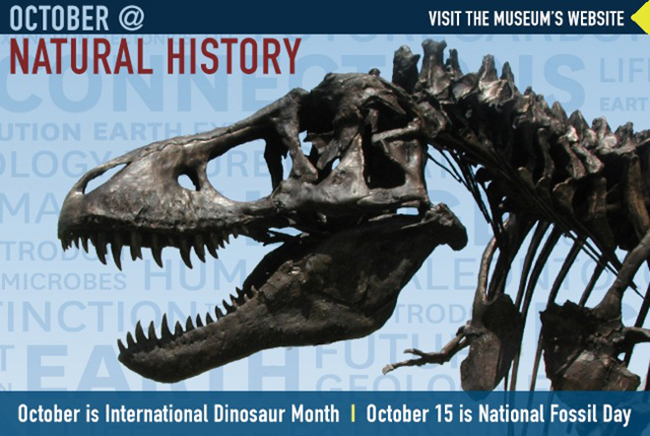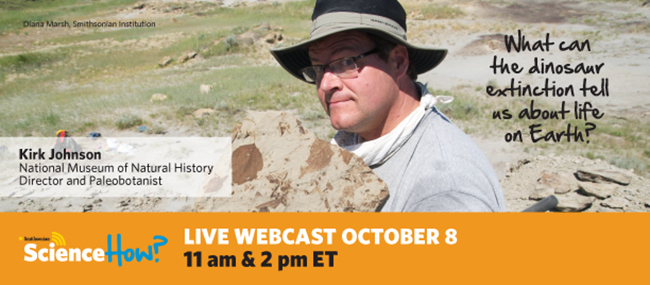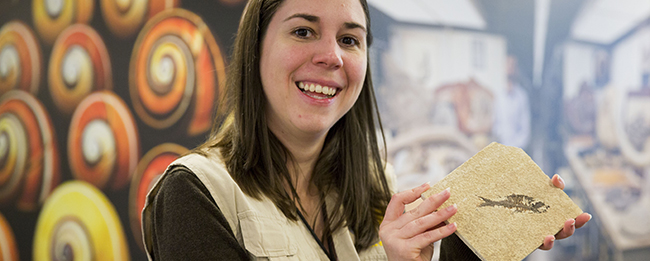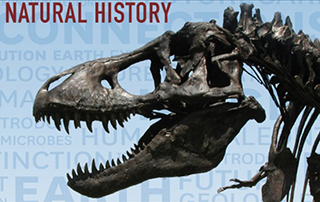| VIEW THIS EMAIL IN YOUR BROWSER > |
 |
 |
|
 |

From the exhibit, Dinosaurs in Our Backyard, painting depicting the Early Cretaceous environment by Mary Parrish. |
Now On View
|
Coming Soon |
Dinosaurs in Our Backyard
2nd Floor
Were there dinosaurs in your backyard? Examine a map of North America that will help you find out. And, take a trip back in time to Washington, D.C., 110 million years ago.
More >
FossiLab
2nd Floor
FossiLab is a real fossil preparation laboratory. Watch through the lab's windows as Museum staff and volunteers prepare and conserve fossils.
More >
Q?rius
Ground Floor
Explore fossils in the Q?rius Collections Zone, where visitors can get up-close access to more than 6,000 specimens.
Explore Q?rius fossil collections online >
|
The Last American Dinosaurs
Opens November 25, 2014
2nd Floor
The last dinosaurs roamed what is now the Western interior of North America millions of years ago. Join us as we piece together a picture of their world by looking at fossils from this ancient time.
More >
Read about preparations for the exhibition in Digging the Fossil Record, the Department of Paleobiology’s Blog >
Nature’s Best Windland Smith Rice International Awards
Opens October 24, 2014
2nd Floor
View sixty award-winning, large-format photographs that bring the beauty of the natural world to the walls of the Smithsonian.
More >
|
| MORE EXHIBITS > |
 |

National Fossil Day logo courtesy of the National Park Service.
|
| National Fossil Day @NMNH--Activities for All Ages |
World Premiere Screening & Discussion--Mass Extinction: Life at the Brink
|
National Fossil Day™ @NMNH
October 15, 2014, 10 a.m. - 2 p.m.
Join the National Museum of Natural History, the National Park Service, and other National Fossil Day partners for a day of fossil fun at the Museum! This event includes presentations and activities with something for every age group.
Talk to scientists and other experts, dig for and draw fossils, and use the tools and techniques that paleontologists use to study fossils and reveal their secrets.
More >
|
Mass Extinction: Life at the Brink
October 27, 2014, 6:45 p.m.
It’s a mystery on a global scale: five times in Earth’s past, life has been nearly extinguished, the vast majority of plants and animals annihilated in a geologic instant. What triggered these dramatic events? And what might they tell us about the fate of our world?
Kirk Johnson, Sant Director of the National Museum of Natural History, and Sean B. Carroll, Vice President for Science Education at Howard Hughes Medical Institute, lead a post-screening discussion.
RSVP here >
|
| MORE EVENTS > |
 |

Photo by Diana Marsh, Smithsonian Institution.
|
| Smithsonian Science How--Mass Extinction: Solving the Dinosaur Mystery
|
Dig Deep--a New Earth Science Program for School Groups |
Free Live Webcasts: October 8, 11 a.m. & 2 p.m. EDT
Meet paleontologist Kirk Johnson, Sant Director of the National Museum of Natural History. See how he and other experts joined forces to figure out what happened at the end of the Cretaceous, 66 million years ago.
Learn more >
View the 2014 - 2015 webcast schedule >
|
Earth Science Week is October 12 - 18!
During our new Dig Deep school program, students learn how to find natural resources using models, geologic maps, and other tools. Learn about the program and register your class or group today! Find out more on the Q?rius blog >
Dig Deep is one of six free, staff-led Q?rius school programs for grades 6 - 12 offered at the Smithsonian’s National Museum of Natural History.
|
| MORE EDUCATIONAL PROGRAMS > |
 |

Illustration of the extinct Caribbean monk seal by Peter Schouten.
|
|
Too Valuable to Lose: Extinct Relative Reveals Rarity of Last Two Remaining Monk Seal Species
|
Extinction Over Time |
A study by Natural History Museum scientists and colleagues focusing on an extinct species, the Caribbean monk seal, has revealed just how unique its only two living relative species truly are.
Read more >
|
Extinctions, the death of all members of a species of plants, animals, or other organisms, have occurred by human and environmental causes. We know of five past mass extinctions. Are we on the brink of a sixth mass extinction?
Read more on the Q?rius website > |
| MORE RESEARCH > |
 |

A volunteer displays a fish fossil from the collections in Q?rius. Photo by Eris Qian.
|
| Volunteer Opportunities |
Support the Museum: Text DINO to Donate |
Share your fascination with fossils or enthusiasm for earth science!
Learn about volunteer opportunities and benefits >
|
New! Text DINO to 202-22 on your smartphone to donate $10 to the Museum. Your donation helps provide free educational programs and exhibitions and contributes to research around the world.
Donate online > |
| MORE WAYS TO GET INVOLVED > |

|
BANNER IMAGE:
Skull of the Nation’s T. rex. Photo by Don Hurlbert, Smithsonian Institution.
Learn more >
|
|
|
| © 2014 Smithsonian's National Museum of Natural History
10th St. and Constitution Ave., NW | Washington, DC 20013 |
CHANGE EMAIL PREFERENCES > |
|